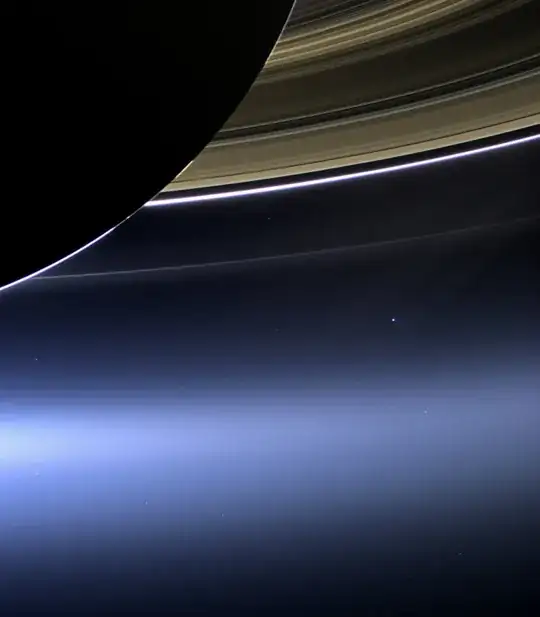Are there any data from spacecraft that visited that planet? How large the Earth is when viewed from that planet?
-
6Note that data from spacecraft is unnecessary. We know the characteristics of the Earth and its distance from Saturn, and mathematics can do the rest. We would never have to visit Saturn to know what Earth would look like from it. – Mike Scott Nov 30 '23 at 10:22
-
Please check the answer of https://astronomy.stackexchange.com/questions/47335/which-planet-viewed-from-which-other-planet-would-appear-the-largest – Nilay Ghosh Nov 30 '23 at 10:37
-
different but related: How will planets behave in the night sky as seen by Mars colonists? – uhoh Nov 30 '23 at 14:02
-
1Perhaps the question is, when viewed from the "surface" of Saturn? – Pablo H Dec 01 '23 at 13:02
-
Odin, a very simple way to think about it. All the planets are "about" the same size. (It's not like there's a planet that's the size of a sun, a galaxy or a pick-up truck!) If you look up tonight all the planets look "about" the same size to your eyes - basically a dot. The Earth's going to be the same. – Fattie Dec 01 '23 at 16:58
-
Visit a solar system model close to you and see for yourself! The angular sizes are preserved. – Jirka Hanika Dec 01 '23 at 20:48
1 Answers
Yes!
It's a tiny blue dot of just about 1.6 arc seconds diameter. Cassini made the most famous image of the "In Saturn's Shadow – The Pale Blue Dot", in remembrance of the first such image from Voyager one: a view of Earth and Moon from Saturn (image: NASA/ESA).

The dark side of Saturn, its bright limb, the main rings, the F ring, and the G and E rings are clearly seen; the limb of Saturn and the F ring are overexposed. The ‘breaks’ in the brightness of Saturn’s limb are due to the shadows of the rings on the globe of Saturn, preventing sunlight from shining through the atmosphere in those regions. The E and G rings have been brightened for better visibility.
Earth, 1.44 billion km away in this image, appears as a blue dot at centre right; the Moon can be seen as a fainter protrusion off its right side. The other bright dots nearby are stars.
JPL shows a few more images, including a zoom image taken of the Moon-Earth-system.
See also the wiki entry on "pale blue dot" as part of the impressive "family portrait" series taken by Voyager 1 in 1990 from a distance of about 40 AU which show most of our solar system planets from 6 billion kilometers distance. Also compare with the successor series taken by the messenger spacecraft 20 years later in 2010 from about the orbit of Mercury.
- 19,369
- 3
- 46
- 80
-
2Not sure whether the OP wanted an angular or pixel size, but could address that part and provide a size of Earth in arcseconds ? – astrosnapper Nov 29 '23 at 22:07
-
4pixel size depends on used camera (and can be checked by following the link to the full-size image), but angular size is fixed for a given distance. I added that. Thanks :) – planetmaker Nov 29 '23 at 22:32
-
-
10
-
Wikipedia article about this image: https://en.wikipedia.org/wiki/The_Day_the_Earth_Smiled – Miles Nov 30 '23 at 22:49
-
1Just to clearify: Voyagers "pale blue dot" was part of the "family portrait"; it was not taken when Voyager was near Saturn. – Abigail Nov 30 '23 at 23:38
-
-
Maybe @An_Elephant was referring to the fact that the image had been intentionally modified, e.g. "The E and G rings have been brightened for better visibility." I wouldn't call that "fake," though. – LarsH Dec 02 '23 at 02:44
-
As a once-upon-a-time photographer I'm used to thinking in terms of "was this taken with a 50mm lens (human eye comparable for 35mm film format)" or a long lens that can change perspective effects. We've all seen the dramatic moon/landscape photos. What focal length lens was used for the Saturn/Earth photo? – BradV Dec 03 '23 at 23:33
-
Thanks planetmaker for providing this absolutely breathtaking photo! I've long admired the 'Blue Dot' photo that Sagan finally got them to take. I think this Saturn/Earth photo is equally breathtaking. – BradV Dec 03 '23 at 23:40
-
The specs are readily avaliable: "Wide Angle Camera [WAC](20 cm f/3.5 refractor; 380-1100 nm; 18 filters; 3.5°x3.5°)", e. g. on https://science.nasa.gov/mission/cassini/spacecraft/cassini-orbiter/imaging-science-subsystem/ – planetmaker Dec 04 '23 at 00:28